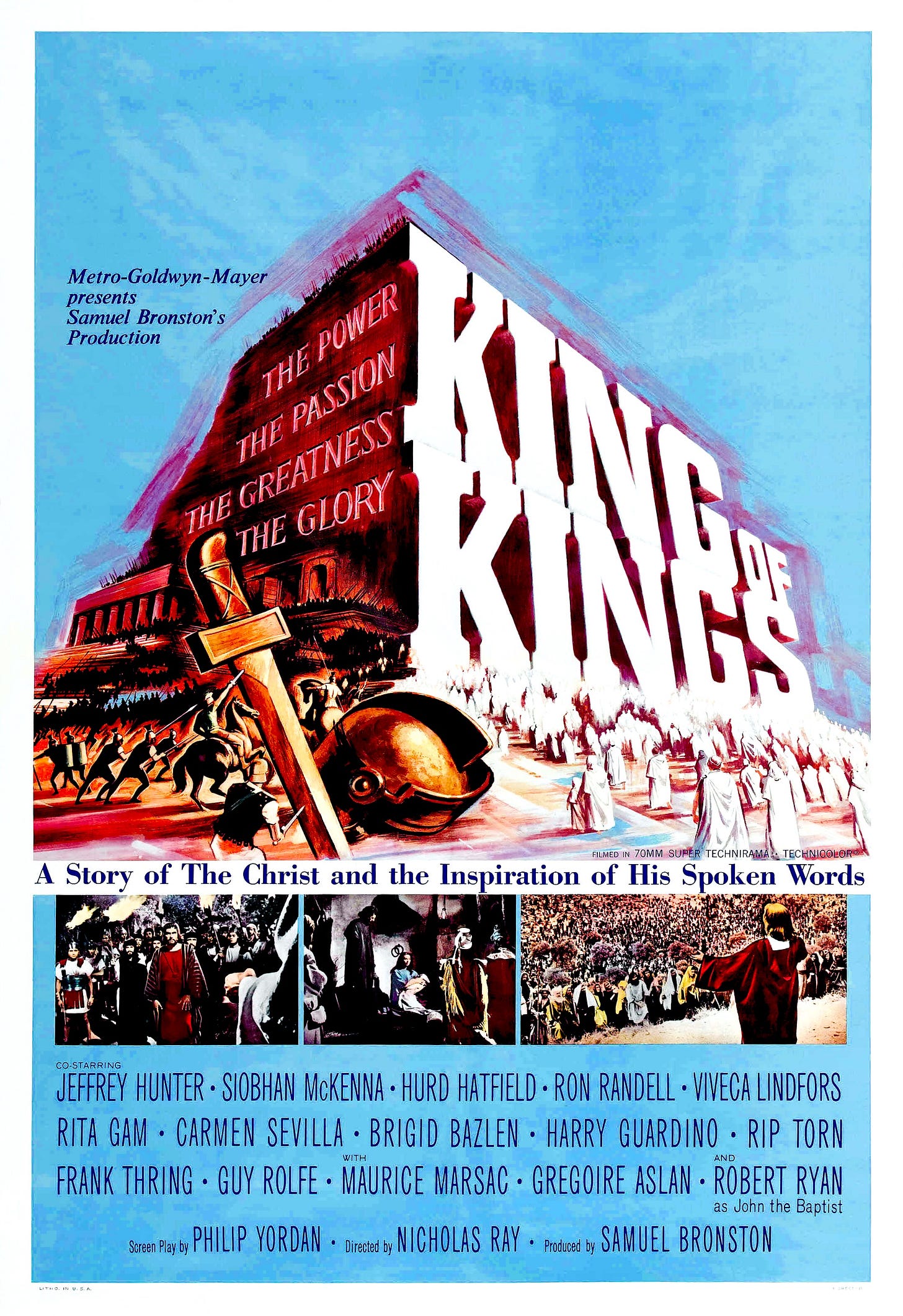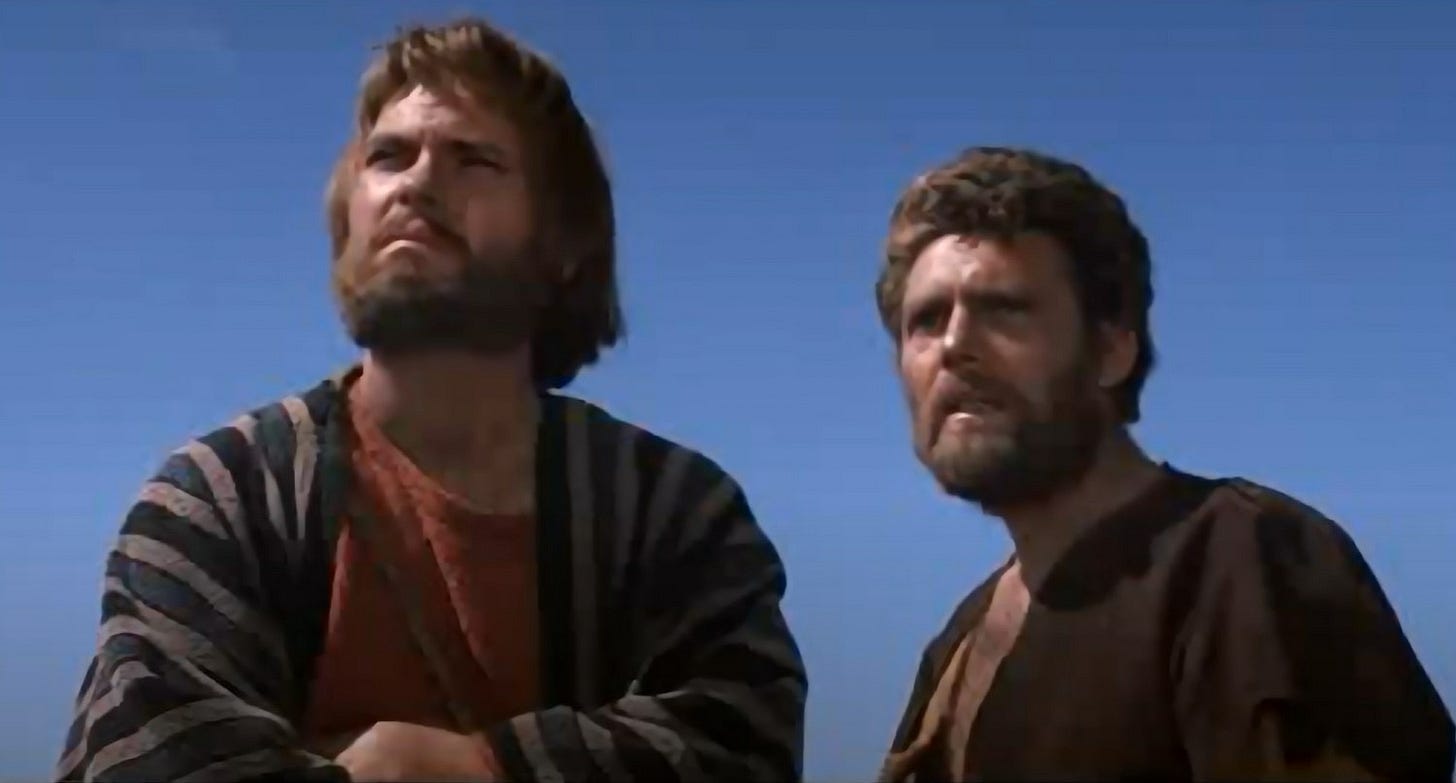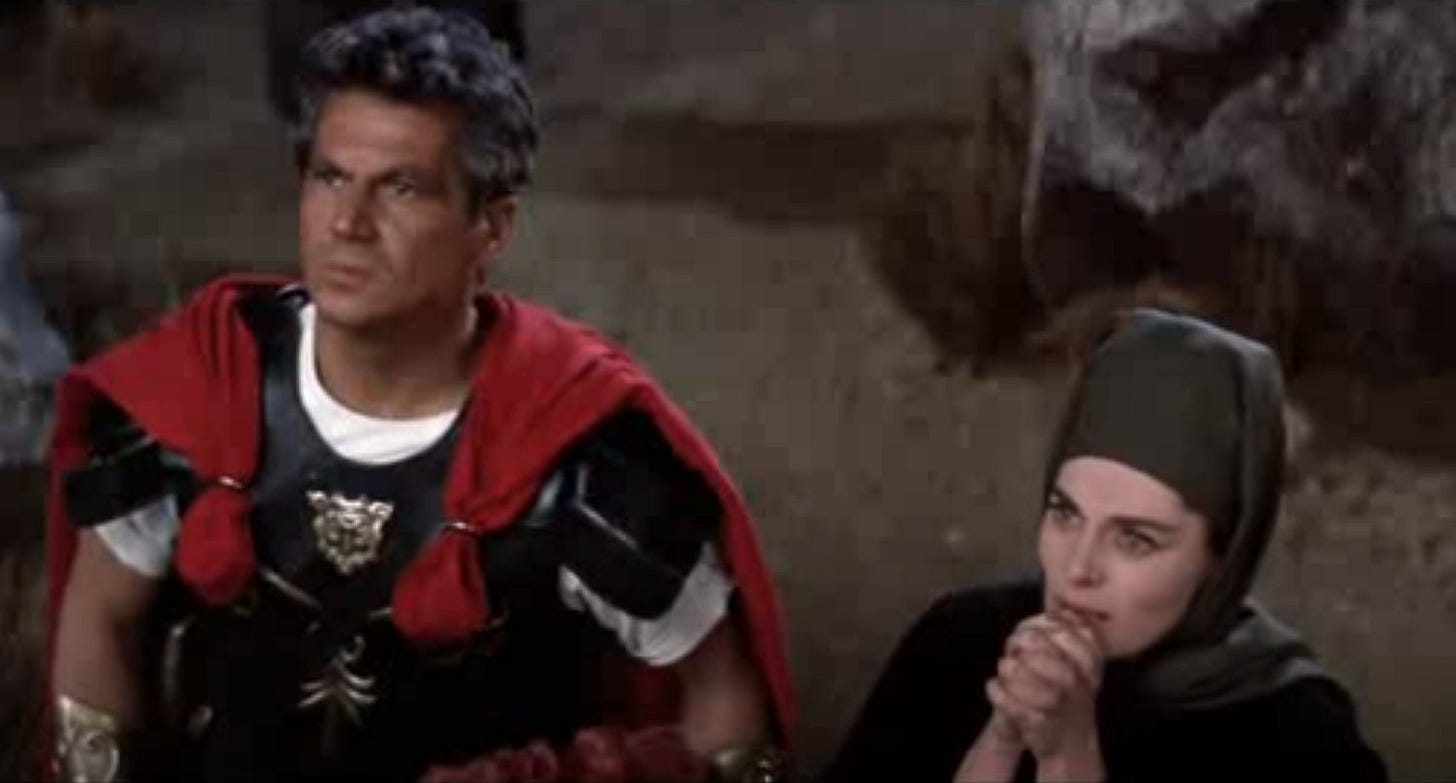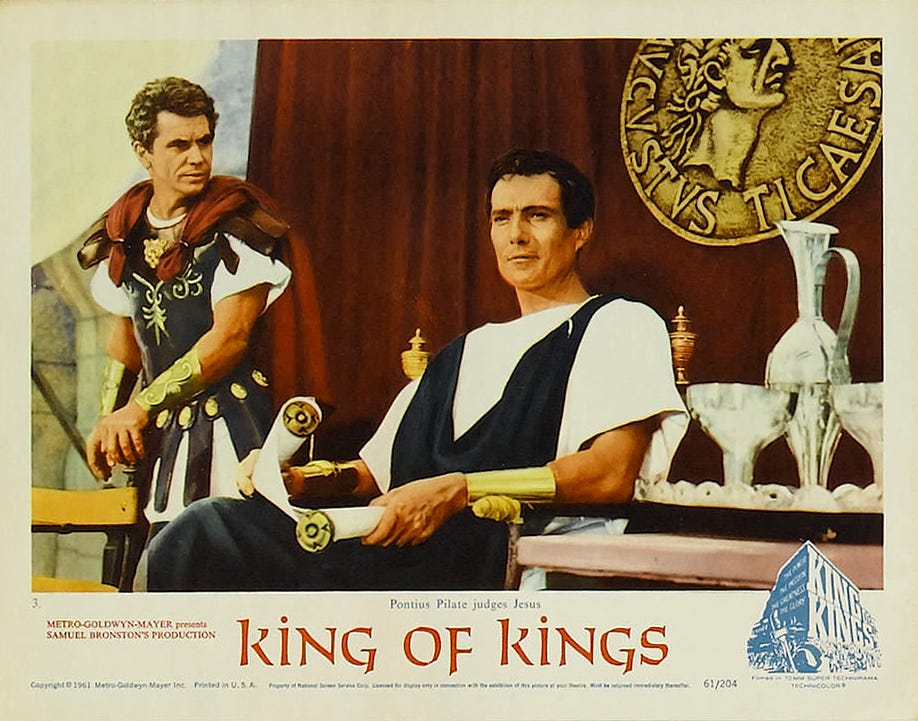"Who do you say I am?" Responses from the Supporting Cast
Part IV of the Celluloid Christ series
One of the pivotal moments in the Gospel of Mark occurs in chapter 8. The disciples had previously been sent out to preach and to heal, taking neither food nor money with them (Mark 6:7-13). They have since returned and have some sense of the pulse of the people with respect to Jesus.
Now Jesus and his disciples set out for the villages of Caesarea Philippi. Along the way he asked his disciples, “Who do people say that I am?”
They said in reply, “John the Baptist, others Elijah, still others one of the prophets.”
And he asked them, “But who do you say that I am?” Peter said to him in reply, “You are the Messiah.” (Mark 8:27-29).
When I teach Christology, I often frame the course as looking at how the Christian tradition has continued to respond to Jesus’ second question. This past weekend, as my deacon candidate students and I covered the period from the early Church through the Council of Chalcedon, we discussed how figures like Justin Martyr, Irenaeus, Arius, Athanasius, Nestorius, and Pope Leo gave answers to that question. Some of these became central to Catholic orthodoxy, others were ultimately rejected as heretical.

This scene from the Gospel of Mark does not appear in Nicholas Ray’s 1961 film, King of Kings, but it might as well have. At its best, the film is a series of character studies of people giving their own answer to that question. In my post this week, I want to look at four of those characters (Lucius, Claudia, Caiaphas, and Barabbas) at three points in the film (their introduction and early scenes, where they are after the Sermon on the Mount, and where they are at the crucifixion). Their character arcs, bent by Christ’s gravity, are essential to the film’s portrayal of Jesus.
Lucius is a Roman centurion who is fundamentally driven by his duty to Caesar. In his first encounter with the adult Jesus, he even says “As you have your duty to your god, so do I to my emperor.” The character, invented for this film, is introduced as being on loan from Caesar to Herod the Great. When Herod orders the massacre of the infants in Bethlehem, Lucius is resistant, but ultimately defers to his duty as Herod suggests that disobeying him is disobeying Caesar.
A dozen years later, it is Lucius who carries out the census in Nazareth, where he meets the Virgin Mary. He recognizes that there is no record of their son, and is shocked to learn that the child was born in Bethlehem. There is a brief moment where it is unclear whether he will report this child, but then again Herod the Great is dead, so he lets the matter drop.
Another twenty years later, he is in direct service to Pilate, and has been keeping tabs on the activities of John the Baptist, Barabbas, and Jesus. He reports on stories about Jesus to a meeting of Pilate, Herod, and Caiaphas, the list being a sort of greatest hits of the Gospels. When asked by Pilate’s wife if these stories can be true, Lucius says “I myself have never seen a miracle,” but some of the cracks in Lucius’ sense of duty to Rome are starting to show. Even after Pilate is annoyed by the listing of events, Lucius continues his report. When he goes to see the imprisoned John the Baptist, Lucius asks John about Jesus, wanting to know if John believes or has doubts. A few scenes later, after Herod has been manipulated by his stepdaughter Salome, Lucius will become John’s reluctant executioner.
Pilate’s wife, named Claudia in this film, is introduced in King of Kings as Caesar’s daughter. She and Pilate speak on their way into Judea, Pilate making clear he sees the mission there as a sort of final test for him to become heir and thus the next Caesar. Claudia, though, is not as ambitious or career-focused as her husband. She is instead somewhat curious about Jesus, even open to him. As noted, she asked whether it was possible the reports of his miracles were true.
Next comes Caiaphas, the high priest. He is introduced in the scene where Lucius reports on Jesus. He is first asked whether Jesus is John the Baptist resurrected (Herod’s great fear), which he dismisses. But he also dismisses any denunciation of Jesus at this point, as Caiaphas has not had the chance to hear Jesus preach. Caiaphas is fairly judicious, but is also deeply concerned about the threat that Rome poses to Judea.

Finally, Barabbas. He is introduced early as the leader of a band of revolutionaries who attack Pilate on his arrival to Judea. He is described as having 10,000 rebels on his side, all of whom seek to expel the Romans. Barabbas hears about Jesus from one of his followers (whom we later find out is Judas), and Barabbas hopes that Jesus will support him in his revolution. Judas seems torn between Barabbas’ militancy and Jesus’ pacifism, and he frequently tries to bring the two of them together.
In one of the central scenes of the film, the Sermon on the Mount sequence, each of these four characters are seen in the crowd. Caiaphas stands with Nicodemus, Lucius with a scarf-covered Claudia, and Barabbas checks in with Judas. Both Lucius and Barabbas wonder if Jesus will be a threat to Rome (with different hopes regarding that outcome). Caiaphas wonders if he will be a threat to Judea. Claudia simply wonders.
It is one of the few impressive scenes in the film overall. Filmed outside of Madrid, the scene includes hundreds of extras played by local citizens who were given relatively period-appropriate costumes to wear for the scene. Jesus moves about the crowd, preaching both central ideas from the Sermon (e.g. the Beatitudes) and also answering questions put to him by the crowd (e.g. “what must I do to inherit eternal life?” and “are you the Messiah?”).
The initial responses of the characters to the Sermon are telling. In Caiaphas’ post-mortem with Nicodemus, the latter admits that he believes Jesus. Caiaphas, however, calls Nicodemus a fool, worrying that Jesus will ultimately, if inadvertently, stir up the people against the Romans and cause an even greater suppression by the empire. He tells Nicodemus that “good or bad, [Jesus] is a threat.”
Barabbas, by contrast does not see Jesus as much of a threat. He rejects Judas’ entreaties to come meet Jesus, saying “I am fire, he is water, we cannot meet.” Barabbas recognizes the fundamental differences between them, even as Judas holds out hope that Jesus will declare himself king of Judea and Barabbas will lead Jesus’ army.
Lucius also rejects any threat from Jesus, reporting to Pilate that Jesus simply preached “peace, love, and the brotherhood of man.” After he leaves, Pilate notes that there was a look in Lucius’ face, something other than exhaustion, a look that suggests Lucius is warming to Jesus’ teaching. Claudia, however, is effectively absent from the post-Sermon scenes.
The film moves towards the passion narrative, paralleling his entry into Jerusalem with an assault on the Romans by Barabbas. The uprising is defeated, Barabbas is arrested, and Jesus heads off to the Mount of Olives with his followers. Judas decides that the his last chance to unite Jesus and Barabbas against the Romans is to betray Jesus, have him arrested, and thus force his hand into calling on divine power to fight back. This of course fails; Jesus is arrested, tried, and sentenced to crucifixion.
In returning to our four characters and their response to Jesus, we must first note the complete absence of Caiaphas. He has not been seen in any meaningful way since his conversation with Nicodemus. The only trial scene we see includes Jesus, Pilate, and Lucius, and it is a private affair. The larger public trial, in which DeMille had Caiaphas both persuading Pilate to crucify Jesus and bribing the Jews to call for Barabbas’ release, is entirely absent. By excising this scene and offering a more limited, more moderate portrayal of Caiaphas, Ray’s 1961 King of Kings is able to avoid the charges of anti-Semitism that were made against DeMille’s 1927 The King of Kings.1 But it also leaves the arc of Caiaphas’ story unresolved.
The scene that replaces this trial is set instead in jail. Lucius comes to see Barabbas, who is shackled along with the two thieves that are to be crucified with Jesus. Barabbas is shocked when Lucius frees him, only to be told that “the man Jesus is dying in your place.” We hear that when offered the choice to free Jesus or Barabbas, Barabbas’ followers simply yelled the loudest. On his exit from prison, Barabbas sees Jesus carrying the cross up the Via Dolorosa. He is compelled to follow along, ultimately catching up to Judas.
In one of the other visually impressive scenes of the film, the camera is placed at the top of the cross, looking down at Jesus, as the cross is raised up. Barabbas and Judas watch at somewhat of a distance. Barabbas is confused, and essentially repeats what Lucius had said to him: “That man is dying in my place. Why should he do that? I never did anything for him.” Barabbas gives his answer to the question from Mark 8:29: Jesus is the one who dies for me, for undeserving me.
Also present at the crucifixion, but much closer, are Lucius and Claudia. As Jesus dies, both of them kneel in reverence, with Claudia bringing her hands together in prayer. Lucius, who led the slaughter of the infants in Bethlehem, who beheaded John the Baptist, who described himself as an atheist, who had never seen a miracle, fills in the role of the centurion at the crucifixion in the Synoptic Gospels and says “truly he is the Christ.”

These other characters are a necessary part of whatever success King of Kings has in portraying Jesus. While he is obviously the central character in the story, Jesus remains a sort of sphinx throughout, difficult to read. The film does not do a great job of communicating his motivations or interior dynamics, assuming instead that viewers simply know them from the Gospels. Yes, the movie includes a scene of Jesus being tempted three times, but it’s more a speed run through the Lukan order than any study of Jesus’ self-awareness. Jesus is mostly portrayed as “man on a mission” Jesus, a mostly persistent and attractive cipher more than a character with any kind of arc.
This isn’t entirely a critique of Jeffrey Hunter, but also of what he was given to work with. While watching I felt like his answer to “who do you say I am” would just be “I’m me,” with not much more to it. The other characters, their responses to the possibilities of Jesus, and their responses to the reality of Jesus, are what tell us who Jesus is. Jesus is the one around whom their lives ultimately bend.
For Caiaphas, Jesus looms clearly as one who makes the threat of Rome more acute, and he disengages from the narrative, literally disappearing from the remainder of the film.
For the others, meeting Jesus molds their identity. Claudia kneels at the cross rather than to Caesar her father. Barabbas realizes maybe he ought not be fire, or that Jesus was the real fire. Lucius’ duty to his emperor is supplanted by a newfound duty to God.
The film is ultimately most effective when it focuses on the other characters, allowing them to be windows into Jesus, icons even. In so doing, perhaps more than any of the other films I’ve reflected on so far, they enable the audience to reflect on “who do you say I am” for themselves.
Stray thoughts about King of Kings:
There are two scenes where supporting characters go to the Virgin Mary for help. One is John the Baptist, following the baptism of Jesus, who asks her how he could baptize Jesus if he is without sin. The other is Mary Magdalene, who wishes the BVM to talk to Jesus for her. There is then a hilarious tip of the cap to Catholic viewers, as the BVM turns inward and says “Intercede…?”
This film continues a trend I’ve been noticing where Judas is either absent for the Last Supper or does not actually eat the bread or drink the wine if he is there. It’s an interesting but consistent narrative choice so far, so I think I’ll do a wrap-up post about this after I’ve finished all the movies on my list.
I am also thinking about doing a wrap-up post about depictions of the temptations. In this film, the temptations are all delivered via disembodied voice, and it doesn’t seem like the film has any idea what to do with them. The one way in which this scene pays off later in the film is that Jesus responds to the temptation of receiving all the kingdoms of the world with “do not put the Lord God to the test,” and he gives the same response at the Sermon on the Mount to a man who asks if Jesus will call down heavenly hosts and drive out the Romans.
Next week in the Celluloid Christ series: The Greatest Story Ever Told (1965), directed by George Stevens. You can find links to all the posts as they come out in the series page.
Ray’s film is sometimes described as a “remake” of DeMille’s, but this is an exaggeration. The claim hinges entirely on the shared title, but there’s no real evidence that Ray self-consciously thought he was remaking DeMille. Moreover, the script Ray follows, and many of his camera and effects techniques, aren’t really homages or specific references to DeMille’s work.




